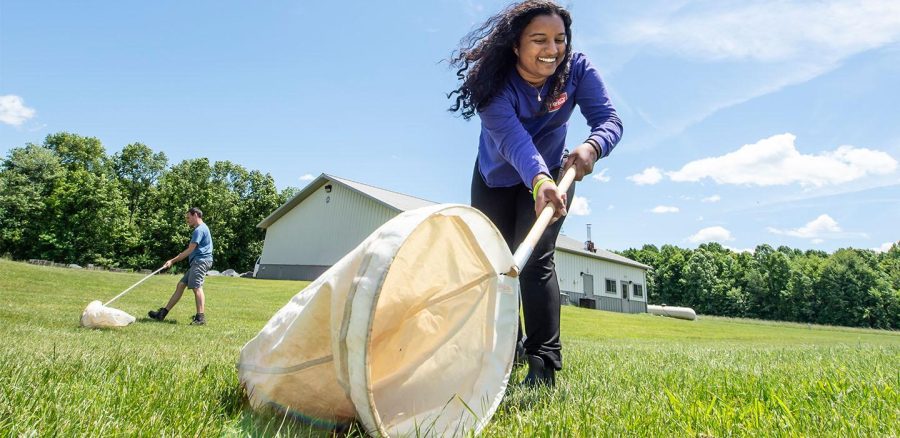Pitt biologists work to ‘equalize risk’ in field research
A woman participates in biology research.
October 13, 2022
After George Floyd’s murder in 2020, Pitt’s biology department started evaluating how to make fieldwork more equitable and inclusive. Elizabeth Rudzki, a graduate student researcher, said she’s noticed a disparity between how marginalized and non-marginalized identities face risk in the field.
“We wanted to figure out what some of these risk disparities were, and how we could address them and come up with creative solutions that help equalize risk across field research so we’re not having such a barrier for students with disabilities or students from different racial identities,” Rudzki said.
A team of faculty and researchers in Pitt’s Department of Biological Sciences created a field safety manual, most recently updated March, that serves to increase safety by minimizing potential risks, outline appropriate responses “should adverse events occur” and identify inequities and their solutions to improve access for researchers of all identities.
Cori Richards-Zawacki, a biology professor and director of Pitt’s Pymatuning Lab of Ecology, said biology faculty felt compelled to detail the process of creating the manual in a paper published Sept. 20 in the journal Methods in Ecology and Evolution.
“We decided that it would be worth sharing our experience as a publication, sharing the things that we learned along the way and the process that we used to write our field safety manual with the larger field of field sciences,” Richards-Zawacki said.
Richards-Zawacki said she initially sent an email to department faculty in 2020 asking if anyone had interest in working with her to create a field safety manual that would have “issues of increased risk” at the forefront. According to Richards-Zawacki, the team spent a year having conversations and working on drafts until completing the document, which they continue to update and modify in meetings periodically.
“That was a really cool effort because it was something that, by design, we decided we wanted to get as many voices from as many different career stages and perspectives from within our department as we could,” Richards-Zawacki said.
Rudzki, the lead author of the paper, said while completing fieldwork in a foreign country during graduate school, the idea “floated” that she would remain overseas by herself to complete the work once the other researchers left. Due to the risks that came with being a woman alone in an area that does not have cell service and having a significant allergy to bees and wasps, Rudzki felt very uncomfortable with the idea. She did not have to complete the research on her own, but she hopes the manual will deter that type of situation from happening again.
“We strongly suggest in the manual that solo field work is not ideal,” Rudzki said. “If it absolutely has to happen, you need to be providing materials and equipment for these students such that they have the ability to call for help.”
Richards-Zawacki said the manual in part focuses on the relationship between field teams and local communities and how things such as nationality of origin, ethnicity and race might lead to different experiences for people from different backgrounds. She said the manual also addresses relationships within field teams, how to build field teams that are respectful of differences in peoples’ backgrounds and challenges that may arise pertaining to disability or being a caregiver.
“We wanted to be inclusive of all the different ways that field research can generate inequities and access between individuals,” Richards-Zawacki said.
According to Rudzki, students expressed a lot of concern regarding interaction with landowners while completing fieldwork. She said the manual suggests that students have a vest that identifies them as a field researcher, that they have other types of apparel that identify them as Pitt researchers and that they carry a letter explaining what they’re doing. She also said that the manual suggests putting signage on vehicles used for field research because often researchers have to use their personal vehicles that don’t look “official.”
“Having stickers and notes to put in the windows of things make it very apparent that this person is working with the University of Pittsburgh and not just some young kid walking around with weird equipment,” Rudzki said.
Kevin Kohl, an associate biology professor who also worked on both the manual and paper, said open and explicit communication is the best way to combat risk in the field. He said it falls on team leaders to create spaces where researchers can share specific needs they may have.
“Otherwise, it falls on the staff or the employees to be like, ‘I need this,’ or, ‘I feel uncomfortable,’ and that puts them in a really difficult place,” Kohl said. “If team leaders can recognize this and be prepared to create safe spaces, I think that’s the best shot we have.”
Rudzki said she hopes the paper inspires other universities, groups and field stations to prioritize forming a diverse group of writers when drafting their manuals.
“Whether that be from different educational statuses, like graduate students versus faculty, or students from different racial backgrounds, gender identities, et cetera, it’s important to have those viewpoints, even though it’s a difficult conversation, because you’re making a manual that is supposed to be helping everyone,” Rudzki said.








